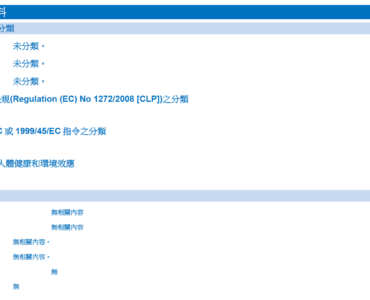What is an SDS?
SDS stands for Safety Data Sheet, which is a document that contains information on the hazards of a chemical substance or mixture, as well as guidance on its safe handling, storage, and disposal. The responsibility of preparing an SDS typically falls on the manufacturer or importer of the substance or mixture. The requirement is established by various national and international regulations, including the Globally Harmonized System of Classification and Labelling of Chemicals (GHS).
Under the GHS, hazardous chemical substances are defined as substances that have physical, health, or environmental hazards. These hazards may include, but are not limited to, flammability, toxicity, carcinogenicity, and environmental toxicity. The GHS requires that SDS be prepared for all hazardous chemical substances, regardless of the quantity produced, imported, or distributed.
In addition to the GHS, many countries have their own regulations that require SDSs for hazardous chemical substances. For example, in the United States, SDSs are required under the Occupational Safety and Health Administration’s (OSHA) Hazard Communication Standard (HCS), which applies to any employer who uses or handles hazardous chemicals in the workplace.
Requirements for SDS in China
In China, SDS requirements are regulated by the State Administration for Market Regulation (SAMR) and the State Administration of Work Safety (SAWS). According to the Chinese regulations, manufacturers, importers, and distributors of chemical substances in China must provide SDSs for all hazardous chemical substances they produce, import, or sell. In China, SDS must comply with the national standard, known as GB/T 16483-2008 (General Rules for the Preparation of Precautionary Labels for Chemicals) and GB/T 17519-2013 (Guidance on the compilation of safety data sheets for chemical products). These standards aim to ensure the safe production, use, storage, transportation, and disposal of chemical products by providing relevant and necessary information to users.
Here are some of the key requirements for SDS in China:
- Contents: The SDS must include information on the identification of the substance or mixture, the hazards it presents, the composition of the substance or mixture, first aid measures, firefighting measures, accidental release measures, handling and storage guidance, exposure controls, physical and chemical properties, stability and reactivity information, and toxicological information.
- Format: The SDS must be written in Chinese and in accordance with the national standard GB/T 16483-2008. It must also follow the format recommended by the Globally Harmonized System of Classification and Labelling of Chemicals (GHS).
- Distribution: Manufacturers and importers of hazardous chemicals must provide SDSs to downstream users, such as distributors and end-users. SDSs must also be updated and re-issued when new information becomes available.
- Review: The SDS must be reviewed and updated regularly to ensure that it remains accurate and up-to-date.
- Storage: SDSs must be stored and maintained for at least 10 years after the hazardous chemical is no longer in use.
Chinese Language Requirements
SDS in China should be written in standard Mandarin Chinese. This is to ensure that the information is easily understood by the target audience, which includes workers, emergency responders, and regulatory authorities. SDS in China must include the corresponding Chinese names for all substances and hazard classifications. Additionally, SDSs must be updated and reissued whenever there is new information that could affect the safety or health of workers, consumers, or the environment.
GTS has translated hundreds of SDS into Chinese for our customers. Get an instant online price quote now for Chinese SDS translation.



Preparing SDS for China involves meticulous attention to regulatory nuances. GTS Translation’s blog offers invaluable insights for ensuring compliance and safety in this critical market.